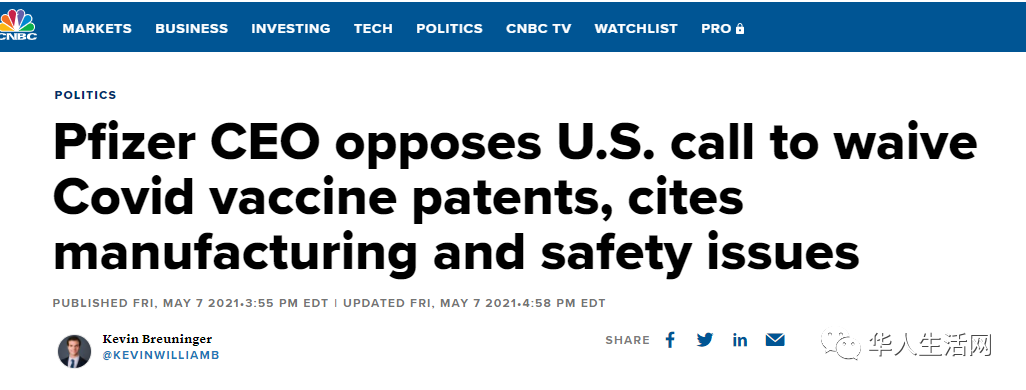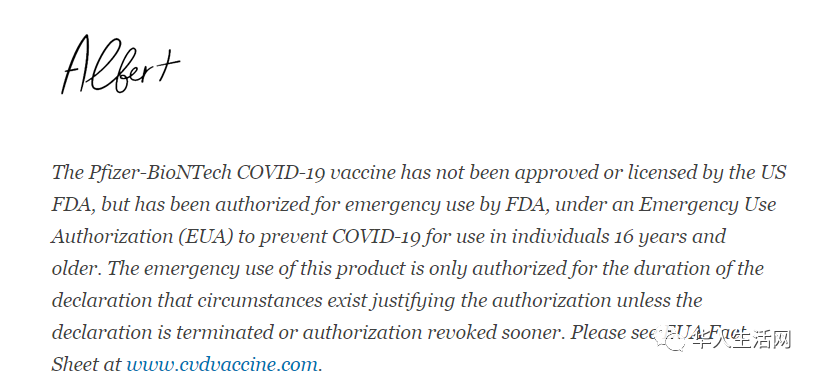最近美國政府疫苗專利權問題引起了大藥廠的強烈震動,我們身在門外的人來看,這個問題就好像就是經濟,政治各種力量的平衡,但事實呢?
在昨天網絡上瘋狂轉載了一封輝瑞CEO給全體員工的信。

信的本質內容是探討輝瑞的核心價值以及長期以來的努力,但是也讓網友們看到了這家新冠疫苗廠在背後的一些故事。

親愛的同事們:
最近,美國貿易代表宣布將討論放棄一些COVID-19疫苗知識產權(IP)的選項,這給世界帶來了一些困惑。輝瑞公司在確保公平和公正地分配我們的COVID-19疫苗方麵做得夠嗎?擬議的豁免權是要帶來解決方案還是製造更多問題?我今天寫信給你,想討論這些問題。
公平和公正的分配從第一天起就是我們的北極星。為了確保每個國家都能獲得我們的COVID-19疫苗,必須滿足兩個條件:任何人都能負擔得起的價格和為所有人可靠地製造足夠的疫苗。
第一個條件在早期就已滿足。早在2020年6月,我們決定通過分級定價提供我們的疫苗。
較富裕的國家將需要支付大約一頓外賣的費用,並向其公民免費提供疫苗。
中等收入國家以大約一半的價格提供劑量。
低收入國家則以成本價提供劑量。
許多最貧窮的社區將通過捐贈獲得他們的劑量。
公平並不意味著我們給每個人都是一樣的。公平意味著我們為那些需要更多的人提供更多。
滿足第二個條件的挑戰要大得多,但我們正在以驚人的速度實現這一目標。由於我們的科學家、工程師和技術工人的聰明才智和辛勤工作,以及輝瑞數十億美元的投資,我們宣布,我們將在2021年向世界提供超過25億劑的藥物。事實上,我們的內部目標是30億劑,所以我們對我們的承諾感到相當放心。今年實現30億劑意味著,通過推斷,2022年將達到40億劑。這些劑量不是針對富人或窮人,不是針對北方或南方。這些是為所有人提供的劑量。我們已經與116個國家簽訂了供應協議,目前我們正在與更多的國家進行深入談判,2021年的總劑量約為27億劑。在敲定所有協議後,我們預計其中的40%,即超過10億劑,將在2021年用於中低收入國家。
這顯然提出了另一個問題。到今天為止,我們已經運送了大約4.5億劑,餘額對高收入國家更有利。AD
這是為什麽呢?
當我們製定分級定價政策時,我們聯係了所有國家,要求他們下訂單,以便我們能夠為他們分配劑量。
實際上,當時高收入國家馬上同意,並保留了大部分的劑量。我個人那時開始關注這個問題,我通過信件、電話甚至短信聯係了許多中/低收入國家的負責人,敦促他們保留劑量,因為供應有限。
然而,他們中的大多數人決定向其他疫苗製造商下訂單,因為當時mRNA技術還沒有經過測試,或者因為他們得到了本地生產的選擇。有些人甚至沒有批準我們的疫苗。
不幸的是,其他疫苗生產商由於不同的技術原因,無法履行其供應承諾。大多數最初沒有選擇我們的國家回來了,由於我們驚人的供應量增加,我們已經開始與他們簽署供應協議。我們預計在2021年下半年,供應平衡將對他們有利,並且在2022年幾乎有足夠的供應給所有人。
上周,我有機會向美國貿易代表提供這些事實,並解釋為什麽建議放棄知識產權隻會破壞這一進展。這使我想到了第二個問題。建議的豁免是要改善供應狀況還是製造更多問題?我的答案是絕對的後者。
當我們創建我們的疫苗時,世界上任何地方都沒有任何mRNA疫苗或藥物的生產。我們不得不從頭開始創建生產基礎設施。憑借172年的優質製造傳統,大量的資本部署,以及更重要的是,一支由高度熟練的科學家、工程師和製造工人組成的軍隊,我們在創紀錄的時間內開發了世界上有史以來最高效的救命疫苗的製造機器。
目前,基礎設施不是我們製造速度的瓶頸。限製因素是生產我們的疫苗所需的高度專業化原材料的稀缺。這280種不同的材料或部件是由19個不同國家的許多供應商生產的。他們中的許多人需要我們的大量支持(技術和資金)來提高他們的生產。現在,幾乎每一克生產的原材料都被立即運入我們的生產設施,並立即可靠地轉化為疫苗,立即運往世界各地(迄今有91個國家)。擬議的COVID-19疫苗豁免,有可能破壞原材料的流動。它將引發對我們所需的關鍵投入的爭奪,以製造安全和有效的疫苗。在製造疫苗方麵幾乎沒有經驗的實體可能會追逐我們擴大生產規模所需的原材料,從而使所有人的安全和安保受到威脅。
我還想說最後一點。我擔心放棄專利保護會使其他任何人不敢冒大風險。
在我們知道是否能成功開發出疫苗之前,我們就已經部署了20億美元,因為我們明白這其中的風險。就在最近,我授權在COVID-19的研究和開發上再支出6億美元,這將使我們在2021年的研發總支出超過100億美元。AD
當然,最近的言論不會阻止我們繼續投資於科學。但我不確定對於數以千計的小型生物技術創新者來說是否也是如此,他們完全依賴從投資者那裏獲得資金,而這些投資者投資的前提是其知識產權將得到保護。
結束大流行病和為世界接種疫苗是一項巨大的、但可以實現的事業。
我們仍然完全專注於盡快為世界各地的患者提供高質量、安全和有效的疫苗,並結束這一致命的大流行病。
再一次,我們不會讓政治阻礙我們的工作,我們將繼續做我們最擅長的事情--創造改變患者生活的突破。

這位CEO一看就是科學家出身,寫東西非常有邏輯。

當然這也讓我們看到了原來一開始疫苗訂製上,有這麽多故事,但是貧困的國家真沒有錢買廉價疫苗嗎?還是這些國家從一開始就沒想真正對待疫情和自己的公民?
全美幾萬人去年夏天開始就做疫苗誌願者,而僅僅輝瑞一家家普通的藥廠為了疫苗就投入了幾十億美元,到頭來卻要變成無償捐獻,不捐還要被罵自私自利,小編不知道這到底是不是算合理呢?也可能這種大愛我無法理解吧。
不知大家又是如何看待這個問題的。
Today I Sent This Letter To Have a Candid Conversation With Our Colleagues About the Drivers of COVID-19 Access and Availability
Chairman and Chief Executive Officer,Pfizer、
The recent announcement that the UnitedStates Trade Representative will discuss options to waive some COVID-19 vaccineintellectual property (IP) rights has created some confusion to the world. HasPfizer done enough to ensure fair and equitable distribution of our COVID-19vaccine? Is the proposed waiver going to bring solutions or create moreproblems? I am writing to you today to discuss these questions.
Fair and equitable distribution was our North Star from day one. In order to ensure that every country can have access to our COVID-19 vaccine two conditions had to be met: a price that anyone canafford and reliable manufacturing of enough vaccine for all.
The first condition was met in the early days. Back in June of 2020 we decided to offer our vaccine through tieredpricing. The wealthier nations would have to pay in the range of about the costof a takeaway meal and would offer it to their citizens for free. Themiddle-income countries were offered doses at roughly half that price and thelow-income countries were offered doses at cost. Many of the poorest communities will receive their doses through donation. Equity doesn’t mean we give everyone the same. Equity means we give more to those that need more.
Meeting the second condition was much more challenging but we are getting there with remarkable speed. Thanks to theingenuity and hard work of our scientists, engineers and skilled workers, and multibillion dollars of Pfizer investment, we announced that we will provide to the world more than 2.5 billion doses in 2021. In fact, our internal target is 3 billion doses, so we feel quite comfortable about our commitment. Achieving 3 billion doses this year means, by extrapolation, 4 billion doses in 2022. These doses are not for the rich or poor, not for the north or south. These are doses for ALL. We have concluded agreements to supply 116 countries and we are currently in advanced negotiations with many more for a total of approximately 2.7 billion doses in 2021. Upon finalization of all agreements, we expect that 40% of them, or more than 1 billion doses, will go to middle- and low-income countries in 2021.
This clearly poses another question. Until today, we have shipped approximately 450 million doses and the balance is more favorable to high income countries. Why is that? When we developed our tiered pricing policy, we reached out to all nations asking them to place orders so we could allocate doses for them. In reality, the high-income countries reservedmost of the doses. I became personally concerned with that and I reached out to many heads of middle/low-income countries by letter, phone and even text to urge them to reserve doses because the supply was limited. However, most of them decided to place orders with other vaccine makers either because mRNA technology was untested at that time or because they were offered local production options. Some didn’t even approve our vaccine. Unfortunately, other vaccine producers were not able to meet their supply commitments for varying technicalreasons. Most of the countries that did not choose us initially, came back and thanks to our phenomenal supply ramp up, we have started signing supply agreements with them. We expect the supply balance to weigh in their favor in the second half of 2021, and to have virtually enough supply for all in 2022.
Last week, I had the opportunity to provide these facts to the US Trade Representative and explain why the suggested waiver of IP rights could only derail this progress. Which brings me to the second question. Is the proposed waiver going to improve the supply situation or create more problems? And my answer is categorically the latter.
When we created our vaccine there was no manufacturing production of any mRNA vaccine or medicine anywhere in the world. We had to create manufacturing infrastructure from scratch. With 172 years of quality manufacturing tradition, substantial deployment of capital, and more importantly, an army of highly skilled scientists, engineers and manufacturingworkers, we developed in record time the most efficient manufacturing machine of a life-saving vaccine that the world has ever seen. Currently, infrastructure is not the bottleneck for us manufacturing faster. The restriction is the scarcity of highly specialized raw materials needed to produce our vaccine. These 280 different materials or components are producedby many suppliers in 19 different countries. Many of them needed our substantial support (technical and financial) to ramp up their production. Right now, virtually every single gram of raw material produced is shipped immediately into our manufacturing facilities and is converted immediately and reliably to vaccines that are shipped immediately around the world (91countries to date.) The proposed waiver for COVID-19 vaccines, threatens to disrupt the flow of raw materials. It will unleash a scramble for the critical inputs we require in order to make a safe and effective vaccine. Entities with little or no experience in manufacturing vaccines are likely to chase the very raw materials we require to scale our production, putting the safety and security of all at risk.
And I would like to make a final point. I worry that waiving of patent protection will disincentivize anyone else from taking a big risk. We deployed $2 billion before we knew whether we could successfully develop a vaccine because we understood what was at stake. Just recently, I authorized spending an additional $600 million on COVID-19 research and development that will bring our total spend for R&D in 2021 to more than $10 billion . The recent rhetoric will not discourage us from continuing investing in science. But I am not sure if the same is true for the thousands of small biotech innovators that are totally dependent on accessing capital from investors who invest only on the premise that their intellectual property will be protected.
Ending the pandemic and vaccinating the world is a massive, but achievable undertaking. We remain fully focused on getting high-quality, safe and effective vaccines to patients all over the world as quickly as possible and to putting an end to this deadly pandemic.
Once again, we will not let politics stand in our way and we will continue doing what we do best – creating breakthroughs that change patients’ lives.


來源網絡










